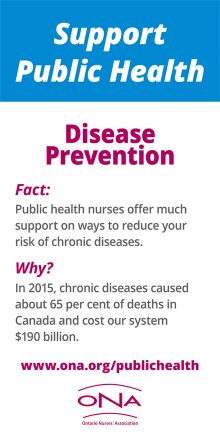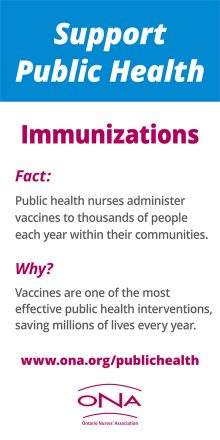The Ontario Nurses’ Association has produced an in-depth series on the importance of public health in Ontario.
Read our flagship publication, Front Lines, as well as first-hand stories on our website and social media.
Our Stories
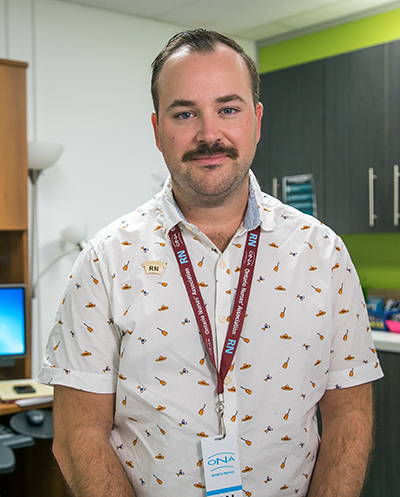
Eric Robertson, RN
A day in the life of a public health nurse offers constant variety. Like all jobs, it has its stressful moments, but the work is always interesting and full of diversity. And, there is never a dull moment, notes Haldimand-Norfolk Public Health Nurse Eric Robertson.
Although public health is typically less well-known than its health-care sector cousins, hospitals and long-term care, it serves a very important purpose: promoting health and well-being through a community lens.
“We aren’t often in the spotlight of disease. We are working in the background to prevent them,” Robertson says. “Our outcomes take longer or come at a slower pace because we need to achieve buy-in from many people.”
Robertson outlines one example of the snail-like pace in public health: “The cessation goal of having a daily tobacco user rate of five per cent in Ontario is set for 2035. That’s 15 years from now.”
Minimizing health burdens
“The scope of public health work includes a forward-thinking approach: preventing diseases and changing communities as a whole. We are constantly working to minimize the burden of health consequences,” Robertson notes.
A seven-year veteran in public health, Robertson has practiced in many facets: vaccine-preventable diseases, cessation programs, community health, and is currently working in the sexual health clinic. “I truly enjoy the direct client contact, and a clinical setting. When a position opened up, I jumped at the opportunity.” The sexual health clinic provides many specialized services to the Haldimand-Norfolk community: sexually-transmitted infection testing and treatment, pregnancy testing with counselling, harm reduction, birth control counselling, and much more.
When not seeing clients, there are lab results to interpret, programs to implement, evaluations to undertake, planning and more. There is never a spare moment, Robertson says.
Challenges include “funding uncertainty”
Although working in public health is rewarding, it is not without challenges. “Funding cuts or funding uncertainty is always challenging. It affects the level of care we can provide,” he explains. “For example, if we have funding uncertainty and a recent vacant position, it may delay recruitment for that position. That creates a strain on the staff that are already working so hard to keep things moving. With that, it often stalls projects that had good momentum.”
With the current government’s plans to decrease the number of public health units from 35 to 10, there are additional worries, but a glimmer of hope. “I hope that this process is well thought out and executed. I hope this isn’t a rushed decision,” Robertson emphasizes.
To advocate for public health and its many community services, visit www.ona.org/save-public-health.
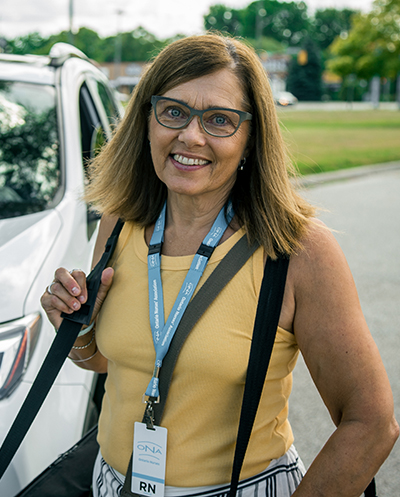
Alice Verwegen, RN
Trust. It is a simple, non-descript five-letter word, but it can mean a world of difference when it occurs between a public health nurse and her client.
The trust may not come easily, speedily, or at all, but when it does, the results can be remarkable.
“It is the foundation for a therapeutic relationship within which our work is done,” says Lambton Public Health Unit Registered Nurse Alice Verwegen.
Once trust is established, there can be further positive steps, with a focus on the goals the clients have set for themselves, she notes.
“We begin the intake process by sharing information about our program, taking a history and welcoming questions while always remaining non-judgmental and caring. Providing this type of milieu in the relationship is key to holding a ‘safe space’ for them, further enhancing a deepening level of trust.”
A seasoned public health nurse with 35 years of dedicated work experience in her community, Verwegen spends her time providing care and service in the Healthy Babies, Healthy Children (HBHC) Program.
Teaching young parents prenatal classes, offering support to new parents and babies, providing breastfeeding assistance, and = can all be part of her day, done mostly through drop-ins and face-to-face home visits.
“We are here for our clients,” she notes. “Whatever it takes – teaching parenting in the home, going with them to appointments, nutrition support, breastfeeding assistance, attachment parenting, helping to navigate the services they need – we will do what we can to support and give families the best start possible.”
The evidence is immeasurable: positive early experiences matter. Right from the womb – mom’s good nutrition, a healthy relationship, positive mental health, abstaining from substance use, adequate and safe housing, and more – will shape a baby’s early brain and overall health development. This provides a foundation for future learning, behaviour, and positive health outcomes. Early referrals into HBHC is encouraged, and allows more time to prepare the parent(s), and collaborate with other professionals that may be involved.
Supports are focused on a client’s needs
“It’s really individualized in how we work with and what we offer each client,” Verwegen says.
“Some require more focused support in certain areas of their life than others; it is very much a tailored program.”
Besides trust, listening is key. Verwegen says speaking with clients and hearing their stories allows Verwegen to understand the why. Why are they in the circumstances they are in? Some never experienced a loving and respectful upbringing with healthy boundaries. This is vital, and clients need to learn this as they begin their own journey of parenting.
“We ask moms, ‘How are you feeling? How is your body recovering? How are you doing emotionally? What has the adjustment been like with your baby?’ Listening to their answers and inferences goes back to trust. By asking, we are giving them the permission to tell us because, as nurses, we can acknowledge their feelings, provide timely health teaching, and offer support. We care about what’s happening in their lives.”
Positive outcomes
About three years ago, Verwegen began to see a young, pregnant client that had a number of complex issues to manage. Initially, she was reserved about “needing” a nurse, until she began experiencing the benefits of the HBHC program.
Verwegen followed her through the prenatal period, providing prenatal classes, dairy vouchers, and the confidence needed to try breastfeeding, which she ended up doing for 15 months.
Today, she is proud of how far she has come, but also very aware that she has a lot more work to do as a mom, and a young adult. Verwegen says her client’s struggle to establish a healthy life for herself, and her child is one that is far too familiar among clients in the program. Many have no idea what babies need, how to encourage healthy growth and development, and how to balance their own needs as a parent.
“My client has done so many good things and she is definitely on a positive path,” notes Verwegen. “Her son is in daycare, he is reaching the appropriate milestones, and mom is addressing her poor mental health with counselling. Sometimes, we have to be patient with people putting the pieces of the puzzle in place. But it’s all worth it in the long run when you feel like you’ve had a little bit to do with the positive steps they’ve taken.”
Stories take their toll
While helping clients improve their lives is very rewarding, the sad and traumatic stories do take their toll on public health nurses. “My day ends at 4:30, but I often think about my clients after hours. You cannot just shut it off. There are a lot of sad and unfortunate issues that people face and, at the end of the day, we are all human and have our own lived experiences to bear.”
The work in public health is expansive and is more than immunizations or West Nile Virus tracking or prenatal classes, she says. “People may not know of all of the programs we offer, such as outbreak surveillance, water and food safety, sexual health, sexually-transmitted infections and blood-borne illness follow-ups with positive cases.”
Word is getting out about harm-reduction programs, needle exchanges, and more. Public health nurses are trying to empower individuals to make informed health choices, thereby reducing risk to the public; health teaching/education will always be a high priority in the job.
Government public health restructuring confusing
Although Verwegen loves her job in public health and is very protective of her clients, she is “very confused” by the government’s plan to reduce public health funding and consolidate Ontario’s public health units from 35 to 10. “There is no step-by-step process that outlines how the restructuring is going to occur, and there are more questions than answers,” she says.
The work public health nurses undertake in local and rural communities is vital to the health and well-being of populations across Ontario. Given the large cuts that are expected in public health and social services, the ability to support the most vulnerable could be at risk, leading to less-than-favourable outcomes for children, parents and families in Ontario.
To advocate for public health and its many community services, visit www.ona.org/save-public-health.
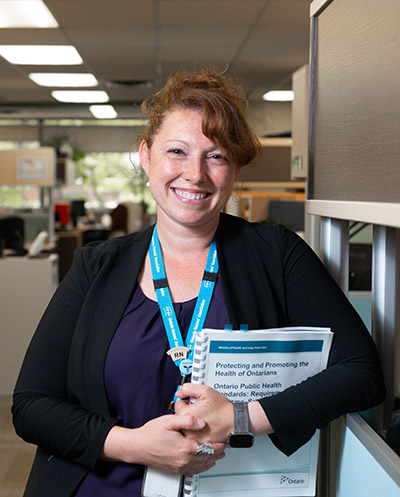
Jennifer Johnston, RN
Jennifer Johnston describes herself as a “glass half-full kind of gal.”
The Windsor-Essex public health nurse, who has an infectious smile (and not in a bad way) and a keen thirst for knowledge could make virtually any bystander stand up and pay close attention to her words.
In her line of work, these traits come in handy. She and her colleagues are responsible for the health and well-being of almost 400,000 people who live in the Windsor and Essex County region. And, some of her direct work involves building relationships.
Johnston – who has been an active executive member of ONA Local 8 for a few years – and her health unit develop ongoing partnerships with many organizations including municipalities, school boards, children’s aid, local immigration support services, health-care practitioners, and police. “You name it, we work with them to come up with ideas and opportunities to improve the health of people in our community.”
Public health tailors programs for health-disadvantaged groups
Public health – less well-known than its health-care sector cousins, hospitals and long-term care – promotes health, well-being, and saves lives through a community lens. While hospital care is more “downstream” in the wellness spectrum – most often accessed once someone is already sick – public health focuses “upstream” to prevent people from getting sick or injured in the first place. It’s about prevention and creating positive conditions for people to reach their full health potential.
“Health is a result of much more than access to health-care services,” Johnston emphasizes. Health and well-being are shaped largely by the conditions in which people live. Conditions can include the safety of their home and neighbourhood, access to safe and affordable healthy food, and a quality education system.
Johnston further explains that poor conditions limit opportunities and choices. Public health has an important role in improving living conditions for everyone, with a special focus on enhancing opportunities for health-disadvantaged groups. These groups can include those living on low income, new immigrants, and people who use substances like opioids or injection drugs.
Public health professionals work in collaboration with others and through a wide variety of programs and services. This includes providing direct-to-client services like home visits to families with newborns, immunizations in schools, smoking cessation programs, and services that keep food and water systems safe like restaurant inspections.
But more importantly, public health has a lead role in identifying opportunities to improve societal factors that influence health. This includes gathering and reporting on population health status, supporting and advancing healthy public policies, and so much more.
“Public health is unique because it focuses on broader health outcomes of everyone in the region, not just clients who use our services,” Johnston notes. “We explore the root causes of poor health and work to change conditions where health-disadvantaged groups can reach higher levels of health and well-being.”
While working to improve living conditions, public health recognizes that health-disadvantaged groups experience more barriers to accessing and participating in health promotion and disease prevention programs and services.
“Public health tailors programs and services to meet community needs and encourages their partners to do the same,” she explains. “A big part of my job is helping to infuse equity-driven thinking into programs and mainstream thinking with the goal of improving health outcomes.”
For example, Johnston is currently working on a community-based project in collaboration with representatives from the settlement, health, and education sectors. The goal is to reduce language barriers experienced by persons seeking local health-care services. The project team is developing strategies to help health-care service providers like hospitals use available language-based services, tools, and approaches to better communicate with their patients and improve outcomes.
Building and maintaining strong partnerships
During the 2014 municipal election, Johnston’s health unit partnered with the United Way to launch a poverty-simulation event. They hosted decision-makers, would-be politicians, health agency CEOs, the media, and others who had the power to make decisions that could positively affect their clients and community.
“The event gave participants a sense of what it’s like to have limited choices and opportunities,” Johnston explains. The experience also helped participants see how organizational systems and community-level decisions – like policies and process – can either help or hinder people. She notes that the outcomes of the event were most rewarding for her. “I cannot tell you how emotional the debrief session at the end of the event was for our participants – it gave me goosebumps.”
In fact, just a few months ago, she met up with a municipal politician who had taken part in the event. “What was meaningful to me was that it was an impactful experience for decision-makers. The politician said to me, ‘that event changed my perspective on everything.’”
As Johnston so eloquently explains, “That’s one of the most important public health roles – enhancing decision-makers’ understanding of local health issues so effective solutions can be put in place to improve people’s lives.”
Public health must be discussed more often
Yet, the innumerable benefits of a strong public health presence in communities need to be talked about much more freely – and often.
The Ford provincial government is cutting the number of public health units across the province from 35 to 10. Diluting the vital community lens which is a cornerstone of all public health units is a common concern among health-care professionals.
Fewer agencies could mean that much-needed and community-specific programs aimed at helping local health-disadvantaged groups could be at risk. In addition, a proposed $1 billion in cuts to health and social services by the Ford government is on the table, which will undoubtedly harm those already experiencing vulnerability.
“I am trying to stay optimistic that changes will present positive opportunities, but given the vast range of programs and services that the Ministry of Health requires public health units to deliver, we are already underfunded,” explains Johnston. “It is challenging to think of how to do more with less while keeping up with our local communities’ growing needs.”
And while her health unit manages more than 300 work plans each year, nothing is set in stone. If a new need comes up in the community, practitioners need to juggle their work to be able to fit it in to their already stretched resources.
Johnston chalks up managing on-the-fly changes to her colleagues. “Public health practitioners are resilient and their strengths are building relationships and identifying approaches that make communities better places to live.” It’s something that she aspires to every day.
“Public health is truly my passion and, if we are doing our job well behind the scenes, people don’t often know about it or understand its value,” she says. “We need to do a better job increasing public awareness of the vital role that public health plays in the lives of Ontarians.”
Radio
Shareables
We have created shareable images that you can download and post to your social media accounts.


